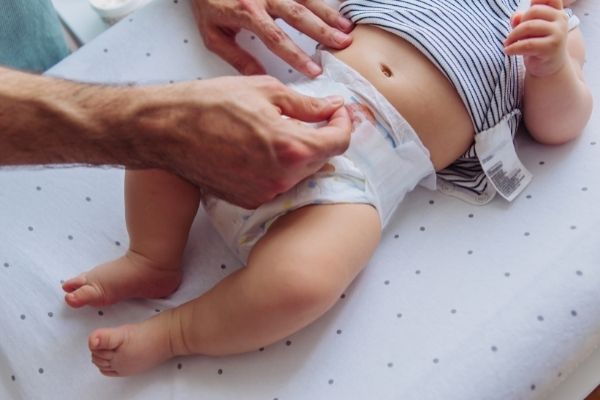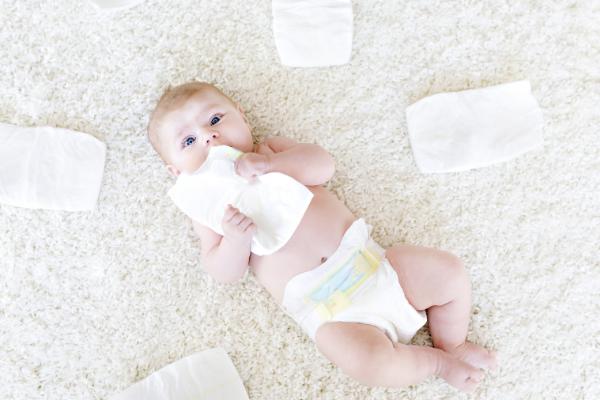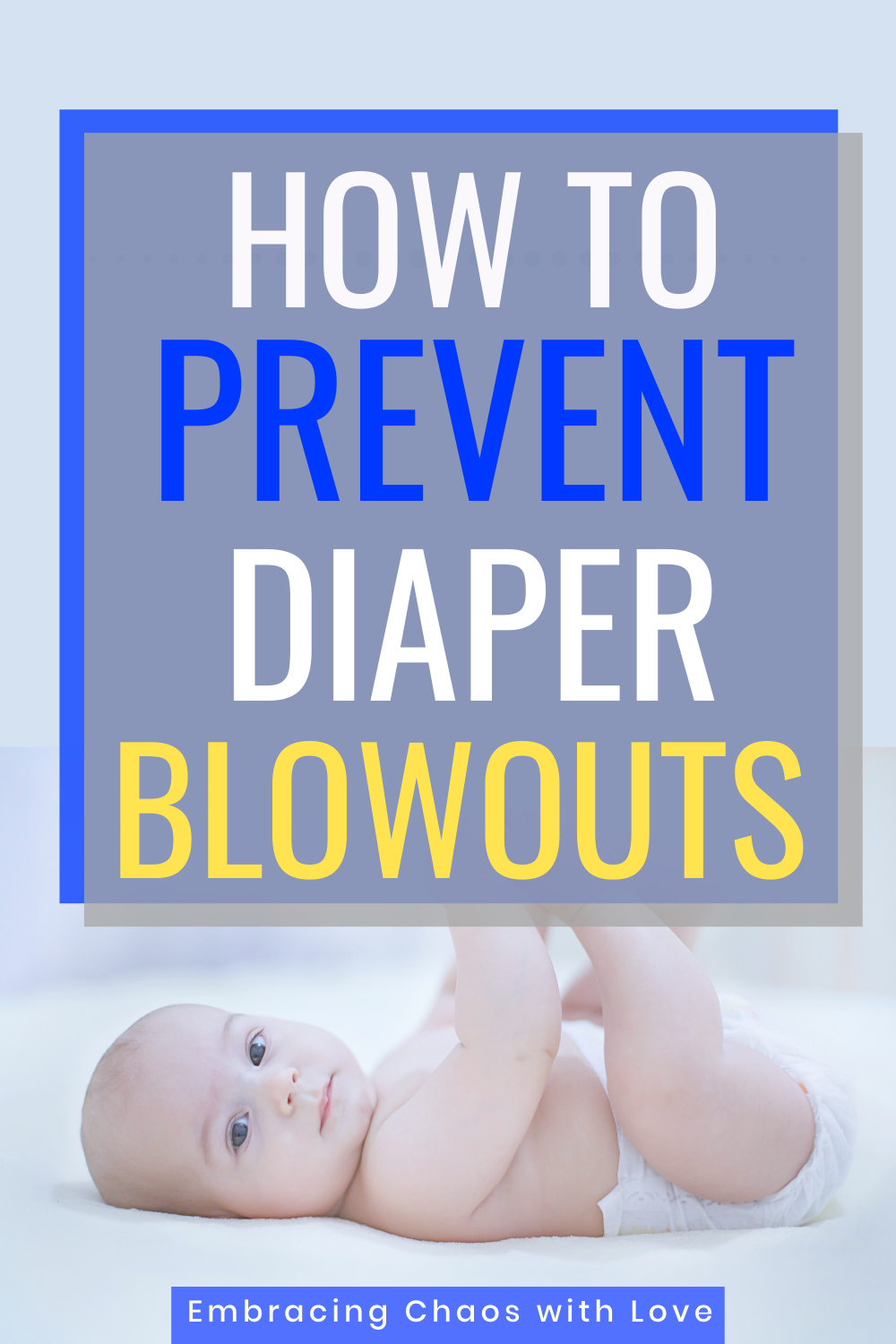A baby diaper blowout is typical, especially during the first few months with a newborn. It can be incredibly messy and frustrating for a new parent. Diaper blowouts can happen to any baby anywhere, and when they do, it’s essential to know how to handle them quickly and effectively.
A diaper blowout is a term used to describe what happens when a baby’s bowel movement leaks out of their diaper and onto the baby’s clothes or whatever surface they happen to be lying on. While it can be an unpleasant situation for both you and your child, there are some steps that parents can take to avoid having these accidents happen in the first place.
The Ultimate Guide To Diaper Blowouts is here to help. This comprehensive guide will teach you everything you need to know about diaper blowouts, from what causes them to how to clean them up. We will also discuss tips you can use to prevent a diaper blowout from happening. With this guide, you’ll be prepared for anything.
What is a Diaper Blowout?
A diaper blowout is a condition that can occur when a disposable diaper cannot contain the waste material inside it. The waste material then leaks out of the diaper, often onto the baby’s clothing.
Diaper blowouts are generally more common in newborns and infants because their waste is more watery than in older children. However, any child can experience a diaper blowout if their diaper is not fit correctly or if it is overly full.
If you suspect that your child has a diaper blowout, it is crucial to remove the soiled clothing and diaper as soon as possible. It would be best to clean the area with warm water and soap. You can avoid diaper blowouts by using a diaper that fits well and checking the diaper frequently to ensure that it is not full.
What Causes Diaper Blowouts?
Several factors can contribute to diaper blowouts. One of the most common reasons is that the diaper is not a good fit. If the diaper is too small, there will be gaps around the legs and waist where waste can leak out, leading to the dreaded diaper blowout.
On the other hand, if the diaper is too big, it will be baggy and more likely to fall. Diaper blowouts can also occur if the diaper is not fastened tightly enough. It is essential to adjust the waist and leg bands to be snug but not too tight.

Another common cause of diaper blowouts is wearing a too full diaper. All diapers have a limited capacity, and once they reach that capacity, waste can start to leak out. It is essential to check your child’s diaper regularly and change it as soon as it becomes full.
Certain medical conditions can also cause diaper blowouts. For example, diarrhea can cause diaper blowouts because the waste is more watery and can leak out the diaper more easily. Children with gastrointestinal conditions such as Crohn’s disease or colitis may also experience more diaper blowouts due to increased waste produced.
How to Prevent Diaper Blowout
There are several things that you can do to prevent diaper blowouts from happening. One of the most important things is to make sure that the diaper fits appropriately. The diaper should be snug around the waist and legs without being too tight. You should also check the diaper regularly to ensure it is not full.
If you use disposable diapers, it is essential to change them frequently. Disposable diapers can only hold a certain amount of waste, and once they reach that capacity, they are more likely to leak, causing a diaper blowout. It is generally recommended to change disposable diapers every 2-3 hours.
If you are using cloth diapers, it is vital to make sure they are fastened securely. You may want to use diaper covers or pins to keep the diapers from leaking. In addition, you should make sure that the cloth diapers are not too full. You can usually change cloth diapers less frequently than disposable diapers, but it is still important to check them regularly.
Tips to Avoid a Diaper Blowout on Babies
- Change your baby’s diaper frequently.
- Ensure the diaper is secure, has no gaps, and is not too tight.
- Assess the fit of the diaper. It should be snug and rest right below the belly button.
- Make sure diaper cuffs are pulled out.
- Wait a couple of minutes after the poop face to change your baby.
- Use a blowout blocker.
- Try a different brand.
- Consult your pediatrician to see if you should change your diet (if breastfeeding) or your baby’s formula.
1. Change your baby’s diaper frequently.
Change your baby’s diaper every few hours to prevent a diaper blowout. A wet diaper causes the cloth to become less absorbent, so when your child poops in an already moist one, it leaks out since the diaper isn’t absorbing the wet crap. Keep your diaper bag well stocked to ensure you have extra diapers in case you are out longer than you thought you would be.
It’s critical to change your child’s disposable diapers frequently. Disposable diapers have a limited amount of waste they can contain before leaking becomes more probable. It is usually advised that you change disposable nappies every 2-3 hours.
If you are using cloth diapers, make sure the cloth diapers aren’t too full, as well. You can typically replace cloth diapers less frequently than disposable ones, but it is still important to examine them regularly.
2. Make Sure the Diaper is secure.
The diaper needs to be adequately secured in order to prevent blowouts. The tabs should be secured so that the diaper fits around your baby’s middle with no gaps. It should be snug but not too tight. It should also rest right under your baby’s belly button.
Most diapers have a guide on where to fasten the tabs too. Look for the little colorful lines on the front of the diaper.
3. Assess the Fit of the Diaper
Invest in a good-fitting diaper. A snug fit is a key to preventing baby diaper blowouts, so make sure your diapers fit your baby well. Pay attention to the weight range of the diaper size you are using.
If the diaper is too tight, it can cause red marks or leaks. If the diaper is too loose, there will be gaps where waste can escape.
4. Make sure diaper cuffs are pulled out.

To avoid baby diaper blowouts, ensure that the diaper cuffs are always pulled out, not buried in between the baby’s thighs. When they’re left inside, they can act as a dam and cause a blowout.
This was one of the main reasons I ended up getting diaper blowouts on my babies. I would forget to ensure the leg ruffles are pulled out! The poop would end up leaking out no matter how little poop there was. So make sure to pull the diaper cuffs out after fastening the diaper to prevent any future mess.
5. Wait a couple minutes after the ‘poop face’
There are a couple of reasons to wait a few minutes before you run to change them. One is that, more often than not, there is more coming. My daughter would always have two poops right after the other. So if I changed her after the first poop face, I was in for a big surprise during the diaper change.
I learned to give it a minute for her to be done entirely. Another reason is to let the poop get a little absorbs so it is not so runny. Diapers are incredibly absorbent and help make runny poops a little more manageable once they absorb a little of it.
Changing too soon can have it all seeping out the second you move your baby and pick them up. Especially if they are sitting, it could make it just squish up more, leading to a baby diaper blowout. Give it a minute, and you can prevent unnecessary messes during diaper changes.
6. Use a blowout blocker
A blowout blocker is a product that you can put in your baby’s diaper to help prevent diaper blowouts. It is a liner that goes against your baby’s skin and has a barrier that catches the poop before it can explode out of the diaper.
You can use the diaper blowout blocker with any brand of a disposable diaper. It is an extender that fastens to the diaper and extends up the back to absorb any mess that may leak out.
This one is machine washable and can fit newborns and babies up to 9 months old. There are also disposable diaper extender pads. Same concept as above. It is a pad with an absorbent material that sticks right to the diaper to help absorb anything leaking out the back of the diaper.
7. Try a different diaper brand.
Try a different brand of baby diapers. The diaper may not be fitting your baby’s body the way it should. Or the diaper is just not absorbing as well as it should, so your baby has way more diaper blowouts. You can also try overnight diapers during the day if you need more absorbent material.
8. Consult your pediatrician
If your baby continues to have frequent blowouts after adjusting the above things, you should consult your pediatrician. Your baby may have an allergy that is causing excessive poops.
They may have you adjust your diet if you are breastfeeding or switch their formula if bottle-fed.
If your baby develops a rash on its bottom be sure to treat it with a cream or butt paste. Aquaphor, coconut oil, and Desitin are all great options for diaper rash. If the rash becomes severe, consult your pediatrician.
Note: Always consult medical advice from your pediatrician or health care professional if you are concerned about any change in your baby’s routine. These are my opinions only and should not be considered medical advice.
Best Diapers to Prevent Diaper Blowouts
I loved Pampers Swaddlers when my babies were tiny. Pampers Swaddlers was the best diaper for my younger babies. The only times I had issues with blowouts were forgetting to pull out the leg cuffs and when the diaper was too small.

I have also heard great things about Huggies Little Snugglers. They have a little pocket in the back that is supposed to catch blowouts and prevent diaper blowouts from leaking out.
Huggies Snug and Dry is a great option for overnight protection or if you need a little more during the day. They absorb super quickly and can hold a lot! I used these overnight with my kids and had no issues.
How to Deal with a Diaper Blowout
Preventing diaper blowouts can be difficult, but it is not impossible. By following the tips above, you can reduce the chances of your baby having a blowout. However, it is essential to remember that blowouts are a common accident, and they will happen from time to time. If you find yourself dealing with a blowout, remain calm and take care of the mess as best as you can.
The best baby tip for dealing with diaper blowouts is to be prepared! Have supplies handy in your car in case you have a blowout while you are out. Of course, you should have your diaper bag stocked with baby’s clothes, disposable diapers, or cloth diapers and wipes.
Plus, I always carry a cleaning kit in my car with an extra pack of wipes, a couple of big zip lock bags or a plastic bag for poopy clothes and trash, and receiving blanket or a towel to lay down while cleaning them.
How to clean a diaper explosion
If you are at home, the easiest thing to do is to remove all the soiled clothing and give them a quick shower or bath. If you don’t have access to a bath or don’t have time for it, you can still easily contain the mess.
- Have a trash bucket or bag ready and open.
- Lay down a towel or a washable changing mat.
- Wipe up as much as you can before removing anything.
- Remove their clothes down off their body, not over baby’s head. Onesies are made to do just this! (The envelope onesie was made with diaper blowout clean up in mind)
- Keep wiping everything down.
- Once you open the diaper try to contain as much of the diaper blowout mess as you can in the diaper before removing.
- Don’t be shy with wipes!
- Wipe quickly and efficiently until your baby is wiped down. (They will be squirming, but you got this!)
- Throw the whole mess away and set aside soiled laundry to spot clean with a mild detergent once the baby is dressed.
- Put on a fresh diaper and the extra change of clothes (that you ALWAYS have in your diaper bag)
- Once you can rinse out soiled clothes in the tub and get as much as you can out.
- Treat baby’s clothes with a stain remover or soak in warm water with Oxiclean.
- Try out all the tips above to avoid diaper blowouts. Good Luck!
FAQs about diaper blowouts
1. Why is my baby having so many blowouts?
There are several reasons why baby diaper blowouts occur. If you have exhausted all of the above tips and your baby still has diaper blowouts there are a few more things you can try.
Excessive diaper blowouts happen because your baby may be expelling a large volume of poop all at once, the brand of diapers may not be working, or your baby may have an underlying allergy. The breast milk may be spoiled, causing them to have looser stool. Be sure always to store your breastmilk safely.
2. Do blowouts mean the diaper is too small?
Frequent diaper blowouts can be an indicator that their diaper sizes are wrong. If a diaper is too small, the diaper may not be covering the butt as much as it should, so poop will escape. Or your baby is expelling a volume of pee or poop that their diaper is no longer equipped to handle.
Red marks around the middle and on their thighs can also be an indicator that their diaper is too small. The diaper cuffs on their legs should not be so tight that they create marks.
3. How to tell if diaper is too big
A diaper is too big if the diaper has to go well above the belly button to go on. The tape tabs should not have to meet in the middle for a diaper to fit. The tabs should meet at the indicated marks on most diapers.
Another way to tell that a diaper is too big is by seeing a significant gap in the back where the diaper meets your baby’s back. It should fit snugly along their back.
4. How to put on a diaper so it doesn’t leak?
To prevent leaks, a diaper should be put on snugly and fastened so that the diaper rest just below your baby’s belly button. You may think that pulling up the diaper will prevent leaks, but if it is too tight, then there is nowhere for pee or poop to go but up or out.
Making sure the diaper is fastened at, or a little below the belly button makes sure there is some room to contain everything. Make sure you are also changing the diaper frequently so that the diaper doesn’t soak through and leak.
5. Are newborn blowouts normal?
Newborns don’t have a regular schedule of when they expel pee or poop, so it is vital to change your baby often. This is why a baby blowout is standard in younger babies because they are so unpredictable. You could change their diaper, then they pee right after a fresh diaper is put on.
If you don’t check or change them often, they will then poop on top of an already dirty diaper, and it could lead to a messy poop. Newborns urinate up to 20 times a day and around four poops a day. So they need to be changed a least every 2-3 hours and checked at least every hour.



